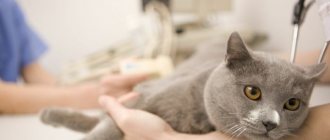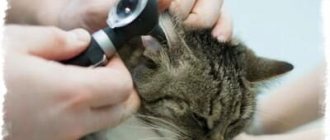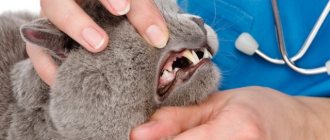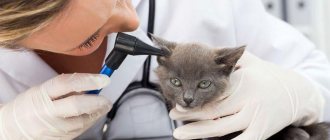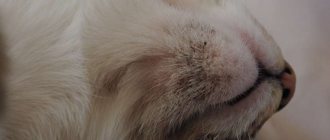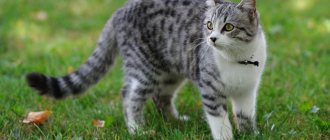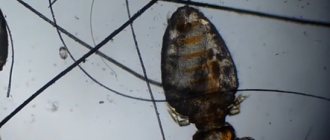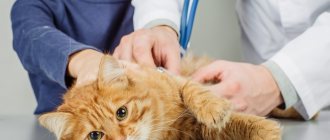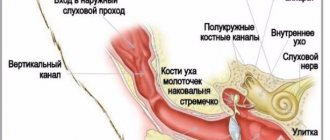Timely cleaning of the paraanal glands is a hygienic procedure necessary for the normal functioning of a cat.
This paired organ is responsible for secreting secretions during defecation and attracts animals of the opposite sex. Blockage of the anal glands is a fairly common problem, accompanied by pain, itching, and the inability to defecate normally. As a result, the glands become inflamed, body temperature rises, the pet’s general condition worsens significantly, he refuses to eat, and sometimes an abscess develops.
There are known fatal cases due to blood poisoning due to the spread of a purulent infection from an abscess throughout the body.
Most often this problem occurs in males, but it also happens in females. Long-haired breeds are most susceptible. The exact cause of blocked glands is not known, but it usually occurs in cats that are obese, have injuries in the anus, lead a sedentary lifestyle, have an unhealthy diet, or are constipated.
Reasons for violation
Normally, the produced secretion has a liquid consistency, discharge occurs during the act of defecation or during hygienic procedures (licking), when violations occur, the secretion itself becomes thick, and irritation of the mucous membrane appears. It is possible that pathogenic microflora enters the gland from the intestine, resulting in bacterial inflammation. If treatment is not started at this stage, an abscess will develop.
Blocked glands are most common in young males who lead a sedentary lifestyle. The reasons for this situation can be a variety of factors:
- abundance of cartilage and bones in the diet;
- injuries in the anal area;
- unbalanced diet, which leads to constipation;
- physical inactivity;
- metabolic disorders and obesity;
- congenital anomalies in the anal sphincter area;
- pregnancy;
- intestinal parasites.
Factors contributing to inflammation
The tendency to blockage of the anal sacs in felines develops regardless of their gender or breed. According to statistics, inflammation of the anus in cats diagnosed in young pets that are obese and do not move much.
Veterinarians tend to identify the following causes of inflammation of the paraanal glands in cats :
- physical inactivity;
- metabolic disorders in the animal and hormonal imbalance;
- helminthic infestation;
- frequent diarrhea;
- soft and liquid food in the animal’s daily diet;
- traumatic lesions of the anal area;
- bacterial infections;
- immunodeficiency states and hypovitaminosis.
Symptoms
When the outflow of secretions is disrupted, excess fluid accumulates in the anal sacs. They increase in size, which causes severe discomfort to the pet.
Owners may notice the following signs of inflammation:
- constant licking;
- restless behavior;
- change in gait;
- anxiety during defecation, because this process causes pain in the cat;
- refusal to eat;
- the pet does not allow you to touch the back of the body;
- sometimes blood in the stool;
- increase in body temperature.
To make sure of the diagnosis, you need to show the cat to a specialist. You can first examine the anus area yourself. You will be able to detect swelling on one or both sides; when pressed, the animal experiences pain, while with gentle squeezing, a light yellow liquid with an unpleasant odor is released from the glands; the more advanced the disease, the darker the secreted liquid.
Inflammation of the paraanal glands in cats: diagnosis and treatment
Inflammation of the paraanal glands in cats: treatment If a cat rides on the floor on its butt, licks or scratches it, then the cat may have inflammation of the paraanal glands.
Anal glands in cats
The paranal glands are two small sacs located on either side of the anus. These are sebaceous glands that produce an unpleasant-smelling liquid called secretion .
Why do cats need paraanal glands?
Cats use the secretions of their paraanal glands to mark their territory. A small amount of secretion is released when the cat goes to the toilet, adding a personal odor to the feces.
Causes of inflammation of the paraanal glands of cats
Inflammation and/or infection of the glands can be caused by a number of reasons. If the anal glands become full, the secretion becomes darker and the consistency becomes denser.
Bacteria that are normally found in stool can penetrate the glands. Typically, these bacteria are flushed back into the rectum during bowel movements. But if secretion is disrupted, bacteria can begin to multiply in the gland, causing inflammation. In this case, the discharge becomes bloody, and the cat's anal glands become filled with pus. An abscess develops. It looks like a swelling on one or both sides of the cat's anus. This swelling causes pain in the cat when pressed. If the abscess is left untreated, pressure in the anal gland will build up until the abscess ruptures through the skin, causing the anal gland to rupture. Pus can also spread to surrounding tissues, causing severe damage to surrounding tissues.
Symptoms of inflammation of the paraanal glands in cats
Symptoms depend on the severity and cause of the disease.
- The cat crawls its butt on the floor
- Cat licks/bites butt
- Discharge from the anal glands
- Seals on one or both sides around the anus
- With an abscess - purulent or bloody discharge from the opened “abscess”, next to the anus (see photo below)
Inflammation of the glands is painful and even a normally affectionate cat may scratch and bite when trying to examine the affected area under the tail.
In some cases, indigestion or diarrhea is observed 1-2 weeks before signs of inflammation of the paraanal glands appear in the cat.
If you notice similar symptoms in your cat, we recommend that you contact a veterinary clinic. 24-hour veterinary clinic Constellation in North-East Administrative Okrug, next to the VDNKh metro station.
Treatment of inflammation of the paraanal glands in a cat
Treatment usually involves cleaning the anal glands by emptying them. If there is an infection, antibiotics are prescribed. If an abscess or rupture occurs, surgery will be required. Most cats are given painkillers and antibiotics for a few days to relieve swelling and inflammation.
Can inflammation of the anal glands in cats be cured?
Recurrent disease of the paraanal glands is uncommon in cats. However, some overweight cats develop chronic inflammation. Obese cats have difficulty emptying their anal glands. For these cats, increasing the fiber content in their diet may be a solution. If a cat has inflammation of the glands several times, the diet does not help, the paraanal glands are removed surgically. Since domestic cats do not need to mark their territory, removing the anal glands will not negatively affect the cat's life.
Treatment
If the disease is detected in the early stages, then therapy is not particularly difficult.
The treatment is based on mechanical cleaning of the glands. The pathological fluid is squeezed out manually, then an antibacterial ointment is applied to the affected area or a special suppository is inserted into the anus. In case of severe inflammation, the doctor rinses the gland cavity with medications and then injects an antibiotic into it.
Then it is necessary to carry out preventive cleaning of the glands to avoid relapse. You can bring the cat to the clinic or do this procedure yourself. The frequency of such manipulations varies from person to person; it can be a couple of times a month or a couple of times a year.
For purulent inflammation, the doctor performs surgical treatment. The cavity is opened, treated with antibacterial solutions and drained, if necessary.
To protect the licking of medicinal substances and licking of the wound, a bandage is applied or a collar is offered. Additionally, antibiotics (subcutaneous or intramuscular) are often recommended.
In case of congenital pathologies of the gland, often recurrent inflammation, if neoplasia is suspected, sacculectomy is proposed - this is the surgical removal of the paraanal glands.
Treatment of the inflammatory process of the paraanal glands
A qualified veterinarian should treat inflamed anal sacs in a cat. The choice of tactics and method of treatment for inflammation of the paraanal glands in cats depends on several factors: the individual characteristics of the animal’s body, the state of the pet’s immunity, the nature of the disease and the neglect of the pathological process with the presence of complications.
In practice, therapy for the disease is implemented by mechanically cleansing the cavity of the paraanal glands from infected secretions, followed by prescribing a course of antibiotic therapy, novocaine blockades and rectal anti-inflammatory suppositories. In most cases, veterinarians prescribe injectable antibiotics from the gentamicin and penicillin groups to their patients. To eliminate discomfort and itching in the anal area, a specialist may decide on the need to take general antihistamines.
To increase the reactivity of a cat’s body and improve the condition of its immune system, the animal needs to introduce food rich in vitamins and nutrients into its daily diet or give synthetic multivitamins for cats, which can be purchased at any veterinary pharmacy.
Chronic inflammation with frequent relapses of the disease requires surgical intervention - resection of the paraanal glands followed by plastic surgery of the perianal zone. Treatment of anal gland abscess in a cat is carried out by surgically opening the anal sacs and draining their cavity.
How to recognize the disease
A disease diagnosed in the early stages of its manifestation will not cause problems for the owner and will not take a lot of time. The best way to determine inflammation of the paraanal glands, if you do not have confidence in your strength and ability to perform the procedure yourself, is to seek help from a qualified specialist.
© shutterstock
You need to know how to carry out the procedure of cleansing the anus at home, otherwise it can lead to a number of complications . For example, animals do not always behave adequately during procedures. Or, when “surgeons” squeeze the glands, they can touch a number of important nerve endings, blood vessels, etc. in the area of the paraanal glands.
Services for cats
Cat grooming price includes:
- haircut (at your request);
- nail trimming;
- care consultation;
- combing.
| Cost of treatments for cats | |||
| Cat Kitty | Procedure time | Price | |
| A haircut | 1 - 1.5 hours | 1800 - 2000 rub. | |
| Bathing drying | 30 - 40 minutes | 1300 rub. | |
| Complex (haircut, washing, claw trimming, ear cleaning, eye cleaning) | 1,5 hour | 3000 - 3200 rub. | |
- Exact prices and cutting time depend on the breed and complexity of the services, are set by the groomer and negotiated with the client;
- Warn the groomer about your pet’s behavior patterns and possible aggression;
- Prices for grooming for exhibitions and haircuts for outbred dogs not included in the price list are negotiable;
- Our specialist will tell you how to properly wash, dry, and comb your animal. She will select the necessary cosmetics taking into account the individual characteristics of your pet.
Internal cleaning
Cleaning through internal intervention involves a number of actions. If you are not sure about even one point, then the best way would be to contact a specialist at a veterinary clinic (strong aversion to the smell or the inability to cause pain to your pet). Before you begin internal cleaning of the paraanal glands, you need to put on clothes that you won’t mind throwing away immediately :
- To avoid infection, wearing gloves is considered a prerequisite;
- Place a set of napkins or towels next to the cat in advance (to quickly get rid of the secretion);
- Lubricate your fingers with specialized cream or Vaseline;
- The substance may remain on the floor or furniture; it is recommended to organize a procedure for cleaning the paraanal glands in the bathroom or if there is an oilcloth;
- Stand on a comfortable side of the animal, lift its tail, and hold the prepared napkins or towels with your free hand;
- In order to properly clean the anal glands in cats, you need to mentally imagine a dial and press the numbers 4 and 8 with your fingers in the area of the cat’s anus.
- It is necessary to press until all the viscous substance from the anus comes out.
© shutterstock
What can a pet owner do?
Inflammation of the paraanal glands in a cat is always easier to prevent than to cure. Therefore, experts recommend that animal owners carry out preventive anal cleanings every 4-6 months. The procedure should be carried out with gloves.
Method of paraanal cleaning:
- Lubricate your index finger with Vaseline and insert it into the cat’s rectum;
- use your thumb and index finger to palpate the paraanal gland, which is shaped like an oval formation;
- squeeze out the secretion of the gland using massage movements;
- Wipe off any excess liquid with a tissue.
The procedure for cleaning the anal sacs can hardly be called pleasant, so in some cases, pet owners entrust it to a specialist.
Where are the anal glands located?
All dogs have two small glands (sometimes called anal sacs or sinuses) near the anus. They perform several functions: marking territory, scaring away enemies, attracting other individuals, intraspecific identification. The anal glands usually secrete a few drops of marking secretion whenever your pet defecates.
Please note that the anal sinuses are located inside soft tissue and are normally not visually detectable. When the glands become clogged or inflamed, they can become enlarged, causing discomfort for your pet.

